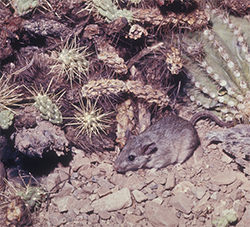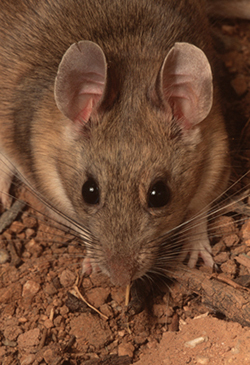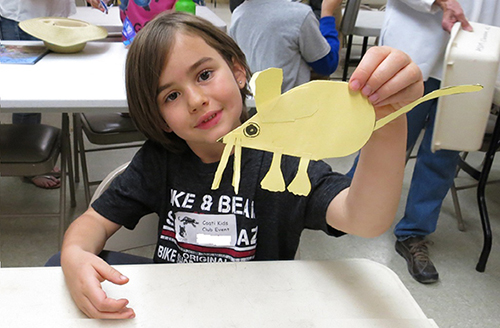
The Coati (co-AH-tee) is a relative of the raccoon with a long nose, masked face, and a striped tail. Coatis are curious and energetic, just like kids!
Coati Club News, August 2017
Pack Rats:
Hidden in the Midden
The Desert Museum is planning a new, indoor family discovery and play space called the Packrat Playhouse. It is inspired by the packrat or white-throated woodrat. These busy nocturnal rodents look for foods like fruit, seeds, and green plants, and they also gather nest materials and things that catch their eye. Packrats are famous collectors - they gather all sorts of items to bring to their nests. They are attracted to shiny things, including people’s keys, coins, and jewelry. They are also known as trade rats because if they find a special item, they will drop it in exchange for something better.

In the Sonoran Desert, packrats build their nests in rocky outcroppings, or at the base of a tree, cholla, or prickly pear cactus. They pile sticks, branches, cactus bits, and even “treasures” like candy wrappers or animal poop on top of their nest to keep out predators and block summer heat and winter cold. Though these nests look messy on the outside, inside everything has its place. Packrat homemakers stash their trash - items like seed pods, fruit husks, and plant bits - in a garbage pile or midden. They also use this midden as their bathroom, peeing and pooping on the trash. If generations of packrats use the same nest, and the nest is protected from weather, the midden materials become cemented together in layers, with the newest material on top.
Packrat Paleontologists?
Paleontologists, scientists who study ancient life, have found 50,000 year old middens. They study the objects inside their layers to learn how big the rats were and what plants were growing around the nest at different times. This gives an accurate picture of how climate in an area has changed. Because of packrat nests, we know that the land we recognize as our Sonoran Desert has only looked like this for the last four thousand years or so.

Pesky Packrats?
Packrats are an important part of their environment. Their nests and holes deliver nutrients and air to the nearby soil. They “plant” the seeds and cacti they collect. And they are food for many animals including bobcats, snakes, and owls. But when they live around people, packrats’ interest in human dwellings and car engines can make them unpopular neighbors. What should we do to prevent packrats from moving in?
- Keep the area around your home clean and trimmed.
- If possible, keep cars in an enclosed garage.
- Avoid using poison. It not only harms packrats but the animals that feed on them.
- To remove a packrat that tries to move in, use a pitchfork or shovel to scoop up the nest materials and put them in a trash can. Watch out for snakes and scorpions!
- Use a live trap to move and relocate unwanted packrats.
Paper Packrat!
You can craft your very own packrat to rule over its own collection of treasures. Download and print this template onto a piece of 8½” x 11” card stock (thicker than regular writing paper) and follow these directions.













